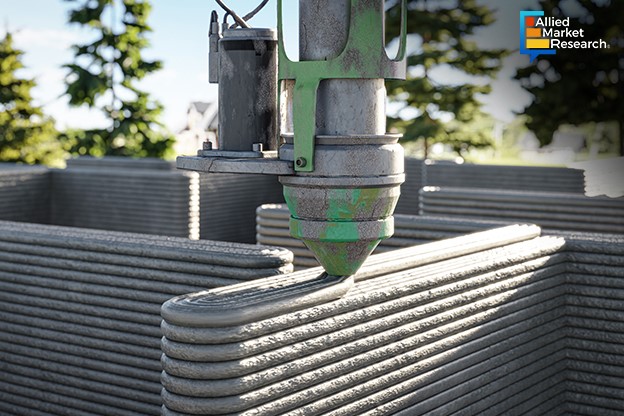Assessing the Economic Impact of 3D Printing Construction Technology

18 Sep
2024
Highlights:
- Introduction
- Material savings, labor costs, and reduced time
- Design flexibility and customization
- Recent initiatives in the CONMA sector
3D printing construction technology is used to print building components or even entire structures using materials like concrete, polymers, and composites. The process involves using a printer to deposit material precisely where needed, allowing for detailed designs and customizations. The ability to create intricate structures and components directly from digital models assures to innovate building procedures. This also leads to multiple economic advantages. The following discussion highlights how this technology is positively impacting the CONMA industry.
Minimizing labor costs, materials, and time in concrete construction
3D printing uses only the exact amount of material needed. The precision reduces costs associated with both purchasing materials and disposing of waste. In addition, 3D printing addresses the challenges of labor shortages and excessive costs in the construction industry. It also minimizes the need for extensive manual labor, including formwork and detailed craftsmanship by automating the material-laying process. This lowers labor costs and helps mitigate the effects of skilled labor shortages. The Wohlers Report 2023 highlights that 3D printing technology significantly lowers labor costs by automating complex tasks. For example, automated 3D printers handle material deposition and formwork, which lessens the need for manual labor and skilled craftsmanship. This can result in savings of up to 50% in labor costs for certain projects.
Moreover, this printing technology speeds up construction by quickly producing the building components or entire structures with high accuracy. This rapid turnaround shortens project timelines, leading to faster returns on investment. Lower costs for equipment make it a more accessible option for a broader range of construction projects, driving further adoption and economic benefits. Reducing labor costs, materials, and construction time, along with lowering installation expenses, boosts the growth of the 3D printing construction industry by reducing overall project costs and increasing efficiency. Automation cuts labor needs, specified material usage narrows waste generation, and faster building times lead to quicker project completions, all contributing to greater economic feasibility and wider technology adoption.
Achieving intricate designs and minimizing multiple trade requirements
3D printing allows creating complicated and innovative designs that are often difficult or impossible with traditional construction methods. This flexibility in design leads to the development of more efficient structures, better space utilization, and aesthetically unique buildings. Although customized designs have higher initial costs, the ability to create personalized structures without additional modifications proves economically advantageous eventually.
Traditional construction projects often require coordination between various trades and specialists, each contributing different components to the final structure. Many of these elements are integrated into a single print, reducing the need for multiple subcontractors, and simplifying the construction process. This integration lowers project management and coordination expenses. Companies that invest in 3D printing technology differentiate themselves in CONMA by offering innovative and customized solutions. This technological edge attracts new clients and draws scope for collaboration with other industries, like architecture and urban planning.
Recent 3D printing construction technology integration in the CONMA landscape
Researchers from the Institute for Advanced Architecture of Catalonia have utilized a Crane WASP 3D printer to construct a 100 m² prototype of a low-carbon emissions building in July 2024. This latest eco-friendly structure, part of the 3D Printed Earth Forest Campus in Collserola Natural Park in Barcelona, was built using local natural materials and earth. The project under the Postgraduate in 3DPA program highlights advancements in sustainable construction practices. In May 2024, Züblin, a German construction engineering firm affiliated with Putzmeister and Strabag, has achieved a milestone by creating a building with load-bearing concrete walls from a single 3D print. Known as the "world first," this new warehouse for Strabag Baumaschinentechnik International in Stuttgart, Germany, demonstrates Züblin's cutting-edge 3D printing technology and serves as a practical evaluation of its capabilities in large-scale construction.
Wrapping up
3D printing construction technology results in cost savings, minimizing material waste, and expediting project timelines. Its ability to automate and streamline construction processes not only reduces labor and material expenses but also accelerates project delivery, leading to faster returns on investment. The economic and operational advantages are anticipated to improve enhance efficiency and lucrativeness within the CONMA industry.
To get more insightful industry updates and business insights on 3D printing construction, contact our analysts now!

Koyel Ghosh
Author’s Bio- Koyel Ghosh is a blogger with a strong passion and enjoys writing in miscellaneous domains, as she believes it lets her explore a wide variety of niches. She has an innate interest in creativity and enjoys experimenting with different writing styles. A writer who never stops imagining, she has been serving the corporate industry for the last five years.
Avenue: Entire Library membership of Allied Market Research Reports at your disposal
- Avenue is an innovative subscription-based online report database.
- Avail an online access to the entire library of syndicated reports on more than 2,000 niche industries and company profiles on more than 12,000 firms across 11 domains.
- A cost-effective model tailored for entrepreneurs, investors, and students & researchers at universities.
- Request customizations, suggest new reports, and avail analyst support as per your requirements.
- Get an access to the library of reports at any time from any device and anywhere.
Related Post
-
How are Submarine Cables Transforming Global Connectivity with Enhanced User Experience?
-
Endoscopy Procedures: Transformations in Techniques and Applications
-
AI-Powered Video Analytics: How the Product Actually Works for enterprises
-
Painting Robots: Transforming Precision Coating and Creative Applications
-
Innovations in Pharmacovigilance Systems Advancing Patient Safety
-
Understanding Edge Security: Keeping Data Safe Near the Source
-
Exploring the Use and Advancements of 3D Laser Scanners in Professional Applications
-
Reinforcing Industrial Controls with Smarter Tools and Training








